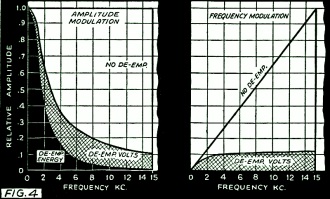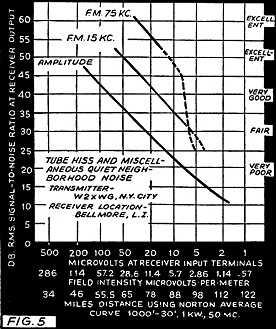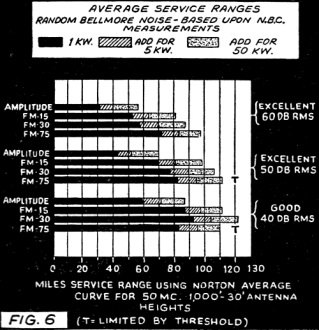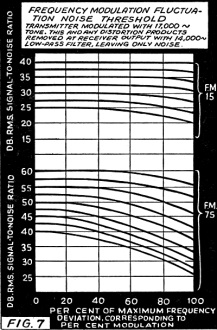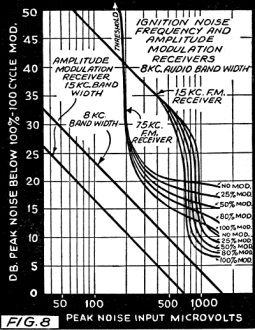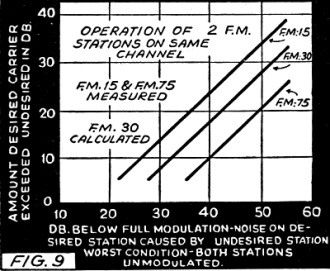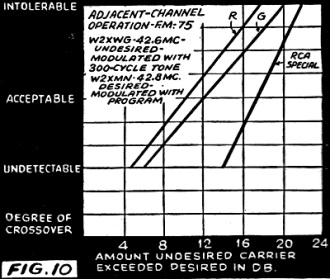An Engineer Analyzes the How and Why of Frequency Modulation
|
|
This is the second and final installment of an article on the topic of frequency modulation (FM) that began with Part 1 in the July 1941 edition of Radio-Craft magazine. Author Raymond Guy, a radio facilities engineer at the National Broadcasting Company (NBC), covers all the fundamentals of FM (a relatively new concept at the time, invented by Major Edwin Armstrong) not just from a functional circuits perspective but also pointing out a broadcaster's concern for channel spacing and broadcasting ranges. Transmitter pre-emphasis, receiver de-emphasis, noise thresholds, and adjacent channel and co-channel broadcasting strategies are discussed here. An Engineer Analyzes the How and Why of Frequency Modulation By special permission of the Association of Technicians, Radio-Craft here presents an article on F.M., from the A.T.E. Journal, which covers the engineering aspects of Frequency Modulation more completely than any previously published in Radio-Craft, and does it in a thoroughly understandable manner. Part I, last month, generalized on the topic and discussed the results of measurements made on the transmissions of N.B.C. Station W2XWG; Part II (conclusion), presented here, describes transmitter pre-emphasis and receiver de-emphasis, noise threshold phenomena, and simultaneous same-channel operation. Part II Raymond F. Guy Radio Facilities Engineer, N.B.C. Fig. 4 - High-frequency pre-emphasis is used in the transmitter and de-emphasis is used in the receiver to improve the signal/noise ratio. The importance of this characteristic in ultra - H.F. broadcasting and its greater effectiveness in F.M. are illustrated at left. Comparison is on the same scale of relative amplitude. Fig. 5 - dB RMS signal-to-noise ratio at receiver output. Fig. 6 - Average FM service broadcast ranges. Transmission and reception on ultra-short wavelengths is not a new idea - not even sound programs utilizing the technique of Frequency Modulation. The truth of this statement was discussed in Part I of this article (Radio-Craft, last month) in which it was shown that the basic method of F.M. for voice transmission and reception was the subject of patents issued in 1905. From this general introduction, the writer proceeded to discuss subsequent technical developments culminating in the wide-band system of F.M. espoused by Major Armstrong. The pros and cons of such characteristics as fidelity, noise threshold, triangular noise spectrum, deviation ratio, field intensity, etc., upon which tests were made at a cost of $30,000 by NBC, were described. We now continue with the further details of these tests, including discussion of pre-emphasis, de-emphasis, F.M. noise threshold (the effects of ignition interference, etc.), and the simultaneous operation of 2 F.M. stations on the same channel. De-Emphasis When the high frequencies are attenuated in a receiver, the high-frequency noise is, of course, attenuated by the same amount. This may make a noisy signal more pleasant to the ear, but it degrades the fidelity. However, if the high frequencies are increased in amplitude in the transmitter, the overall fidelity will be restored. Nevertheless the noise which comes in at the receiver remains attenuated and therefore a reduction of noise results from this practice. The use of a 100-microsecond filter to accomplish this purpose has been adopted as standard practice in Television and ultra-H.F. sound broadcasting by the Radio Manufacturers Association and recently by the F.C.C. It has actually been in use for several years. A 100-microsecond filter is a combination of resistance and capacity which will charge to 63% of maximum, or discharge to 37% of maximum in 100 microseconds. It was shown that in F.M., the noise amplitude decreases as its frequency decreases whereas in A.M. it doesn't. Therefore, de-emphasis is more effective in F.M. Consider Fig. 4. The full rectangle at the left is the A.M. noise spectrum. The full triangle at the right is the F.M. spectrum. The application of de-emphasis reduces these areas to those combining the hatched and black sections. Squaring those ordinates gives the black areas, corresponding to power, or energy. Extracting the square root of the ratios of these black areas gives the r.m.s. voltage advantage of F.M. over A.M. It is 4, corresponding to 12 db. Bear in mind that this 12 db. includes the gains contributed by both the triangular noise spectrum and de-emphasis. The spectrum advantage was 4.75 db. Hence the de-emphasis advantage is 12 db. minus 4.75 db. or 7.25 db. All commercial F.M. receivers include de-emphasis and all F.M. transmitters include pre-emphasis, It's an F.C.C. requirement. Now let's sum up. We saw (Part I) that the F.M. noise spectrum advantage was 4.75 db., the de-emphasis advantage was 7.25 db. and the deviation ratio of "F.M. 75" was 14 db. Combining these gives us 26 db. Let's now see what advantage we actually measured as part of the field test project. Your attention is directed to Fig. 5 which has on it a great deal of information. It actually condenses to one illustration much of the data we sought and obtained. Many pages could be devoted to it. The curves may be extended to the upper-left in parallel lines as far as desired. The actual field intensity of the noise can be determined from the A.M. curve. For instance, for 10 microvolts at the receiver terminals the A.M. signal-to-noise ratio is about 25 db. or 18 to 1. Hence the noise is 1/18 of 10 microvolts, or 0.6-microvolt r.m.s. The ordinates are identified in receiver input microvolts, microvolts-per-meter and miles distance. Use the one you are most interested in. If you want condensed distance tables refer to the bar chart, Fig. 6. Compare the measured gains with the calculations we went through. They look to be the same. They are. That means we found that the theoretical gain of F.M. can be and was obtained in practice. Note the dotted sections of the F.M. curves. They are dotted to indicate that operation is not only below the "noise threshold" but is far enough below it that a noticeable increase of noise results as soon as modulation occurs. The dotted sections represent noise in the unmodulated condition. During modulation they break even sharper than indicated. Since there is no such thing as a noise threshold in A.M. there is no such break. Wherever usable A.M. entertainment service is provided "F.M. 15" is 12 db. quieter and "F.M. 75" is 26 db. quieter. F.M. Noise Threshold An interesting series of events takes place in a Frequency-Modulated system when the noise peaks equal or exceed the peaks of the carrier. The result is a rapid increase of the noise level or decrease of the signal-to-noise ratio with modulation. In Frequency Modulation wherein the maximum swing is 150 kc. the point where this begins to occur is reached when the unmodulated signal/noise ratio is about 60 db. When the unmodulated signal/noise ratio is less than about 60 db., or 1,000 to 1, the noise level rises with modulation, and as the noise peaks exceed the carrier peaks by a considerable amount, this noise level may go up 20 db., or 10 times. When operating above the threshold limit the noise changes very little as the station is modulated. Below the threshold limit the effect is not unlike harmonic distortion in an overloaded amplitude transmitter. In Frequency Modulation of a lesser swing, such as 30 kc., a similar effect occurs. In this case, however, the threshold limit occurs at about 35 db. signal/noise ratio. Figure 7 shows the results of some of the measurements we made. In order that the noise would not be confused with the small amount of inherent distortion in a practical F.M. system, the measurements were made in such a manner that the effects of distortion were eliminated. This was done by modulating the transmitter with a 17,000-cycle tone and eliminating at the output of the receiver with a 14,000-cycle low-pass filter, not only the fundamental modulating tone but all distortion products, leaving only the noise. This effect has no doubt been observed by many without being understood. It is inherent in a frequency modulation system. The noise threshold in the case of an "F.M. 40" system having a total band width of 100 kc. occurs at about 43 db. Since this provides a very good signal/noise ratio and the required band width is only 100 kc., F.M. 40 is believed by many to have more overall merit than F.M. 75 when the comparative gains and limited space in the allocation spectrum are considered. So far as is known, the data on the F.M. threshold effect presented here, and data published by Murray Crosby of R.C.A.C. constitute the only measured data ever published. Figure 8 shows ignition noise measurements with peak noise input microvolts plotted against peak signal to noise ratio, based upon the signal resulting from maximum 400-cycle modulation. The "F.M. 15" threshold is shown. The F .M. 75 threshold is not shown because at the time the measurements were made A.C. hum within the system made the accuracy of S./N. measurements in the 60-db. region uncertain. It should not be assumed that peak S/N ratios of 20 or 30 db. are unusable when the noise arises from ignition systems because it isn't true. The relative infrequency of ignition peaks produces an audible result which is very deceiving. Ratios as low as 10 db., while distracting, do not entirely ruin service as is the case with fluctuation noise. It will be noted that the curves of ignition noise threshold flatten off at the bottom. This is to be expected from the character of ignition noise. The impulses are very short in duration, very high in amplitude and (relatively) widely separated. They literally blank-out any small portions of the signal waves, without impairing the remainder. The short, blanked-out intervals of the signal change little over a wide range in noise peak amplitude. Once an ignition peak has risen to the value required to control the receiver and blank-out the signal a further rise in the noise level will not occur until the peak increases in breadth, or duration, or until there is a sufficient rise in certain low-amplitude components of ignition noise having fluctuation noise characteristics. The peculiar shapes of such curves below the threshold values are due to the wave shapes and crest factors of ignition noise, but they are also influenced by the method of measurements. Fig. 9 - Amount desired carrier exceeded undesired in dB. Fig. 10 - Adjacent-channel operation FM band. Operation of Two F.M. Stations on the Same Channel By referring to the section covering noise interference it can be seen that the worst condition of shared-channel operation occurs when both stations are un modulated and a fixed beat-note, therefore, results. It will also be seen that the higher this beat note the greater will be its amplitude. Figure 9 was made on the basis of the worst conditions, which occur when the difference in carrier frequency reaches approximately 5,000 cycles. Were it not for the effect of de-emphasis in the receiver the beat-note amplitude would rise with frequency. However, de-emphasis of the high frequencies prevents that from happening and the effect may be further understood by referring to the section on pre-emphasis and deemphasis. It will be noted that the noise on the desired station caused by the undesired station varies inversely with the deviation ratio; F.M. 75 has a deviation ratio of 5 compared with 1 for F.M. 15. When either of the stations producing the beat-note becomes modulated, the beat-note disappears because one carrier sweeps across the other one. When the desired station is approximately 20 db. stronger than the un-desired station, interference and cross-talk effects become unnoticeable. At 12 db. difference they are noticeable but it is the opinion of some engineers that the 12-db. ratio would be tolerable. Frequency Modulation offers a great advantage over Amplitude Modulation in the allocation of stations on the same frequency. In A.M. the carrier amplitude of the desired station must be 100 times, or 40 db. greater than the undesired carrier amplitude for a 40-db. signal to beat-note ratio. For F.M. 75 it need be only 10 db., or 3 times greater. For F.M. 30 it need be only 17.5 db., or 8 times greater. For F.M. 15, it need be only 24 db., or 10.5 times greater. The result is that F.M. stations can be located much closer geographically, and therefore many more station assignments can be made per channel. All interference due to sky-wave transmission from distant stations is automatically rejected in F.M. because the interfering signals never reach the high amplitude required. This is not so in A.M. transmission. Figure 10 shows the results of adjacent-channel measurements using one of the RCA Field Test receivers and 2 commercial models of other manufacture. It should be noted that the undesired station was modulated with fixed tone of uniformly high modulating level. As a result the interference was probably somewhat more severe than would be the case for program trans-mission in which the average modulating level is rather low.
Posted March 16, 2023 |
|

